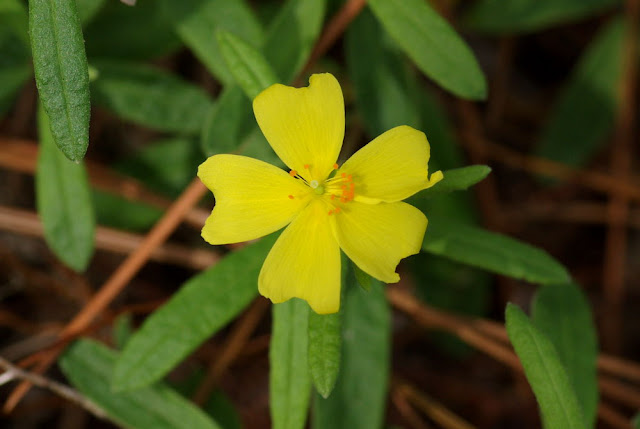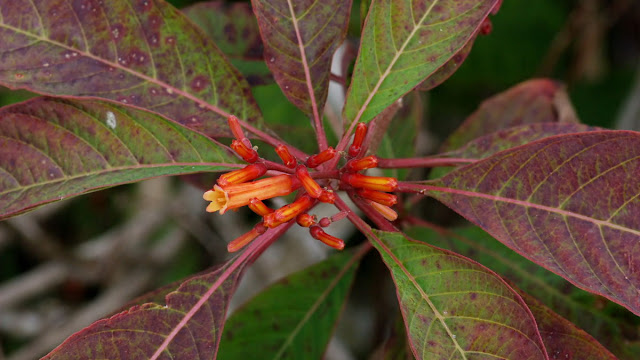In January of this year, I visited Frenchman's Forest, a natural area in northern Palm Beach County. At that time, we had severe drought conditions and many of the plants were stressed. One indication of that stress was that I had never been to a natural area in which so many different kinds of plants had insect or disease damage.
Most gardeners view insect herbivores and diseases with dismay; however, for the most part, native plants take them in stride and are usually able to resist them when better conditions return. The most serious problems usually lie with introduced, non-native insects and diseases that native (and garden) plants have not had a co-evolutionary history with. Thus, in a natural area like Frenchman's Creek, native insect herbivores and plant pathogens can be viewed as yet another group of organisms that keep things in balance and add to the biodiversity of the natural area.
 |
| A single leaf of Chromolaena odorata (jack-in-the-bush) with evidence of three different organisms sustaining themselves on the plant: (1) powdery mildew as seen in the fuzzy white area in the upper left portion of the leaf; (2) leaf miner producing the large milky white area in the upper half of the leaf; and (3) an unidentified organism that is causing the speckling of tiny dots. |
 |
| Crocanthemum corymbosum (synonym: Helianthemum corymbosum) (pine barren frostweed) is adapted to dry sandy sites and was unaffected by the drought. However, many of the colonies appeared to lack vigor due to overly shady conditions. Long considered congeneric with the Old World Helianthemum, there is molecular genetic evidence that the New World frostweeds should be placed in their own genus (Crocanthemum). See, e.g., Guzmán & Vargas 2009. |
 |
| Hamelia patens (fire bush) was abundant in Frenchman's Forest and this was the first time that I had seen it as a native plant growing wild in Palm Beach County. |
 |
| Hamelia patens (fire bush) bears abundant berries that are eaten by various birds and mammals. |
 |
| Iresine diffusa (blood leaf) has tiny 1-seeded fruits that bear fluffy hairs and are dispersed by the wind. It is a common plant of disturbed, open, sunny and semi-shaded sites in Palm Beach County. |
 |
Physalis pubescens arenicola (husk-tomato) was beginning to sprout new shoots from deep, subterranean rhizomes. |
 |
| Psychotria nervosa (wild-coffee) was abundant at Frenchman's Forest. This carefully rolled up leaf is the handiwork of a moth caterpillar that feeds on wild-coffee. |
 |
| Psychotria sulzneri (velvet-leaf wild-coffee) tended to grow in more shady or moist areas than Psychotria nervosa. Both plants are outstanding landscape plants whose flowers provide pollen for native bees and nectar for a wide variety of both large and small butterflies. Their red berries are dispersed by birds and provide additional value to wildlife. |
 |
| Pteridium aquilinum (bracken) grew to enormous heights in one location and covered many square yards of ground. |
 |
| Richardia grandiflora (large-flowered Mexican-clover) seems to occur in every open, sunny, terrestrial habitat in Palm Beach County. It readily takes over lawns and is now a much-hated lawn weed that is resistant to most broad-leaf herbicides. |
 |
| Sambucus nigra ssp. canadensis was common at Frenchman's Forest. This plant had foliage with the unmistakable signs of being infected with a plant virus. |
 |
| Solidago fistulosa (pine barren golderod) was greatly stressed by the drought and was afflicted with powdery mildew as well as by goldenrod blister galls. The latter are caused by the larvae of a tiny midge with the aid of a mutualistic fungus. The larvae never occur without the fungus and there is a possibility that they feed solely on the fungus and never directly eat the leaves (see Stireman et al. 2008). |
 |
| Stipulicida setacea is a tiny plant that forms rosettes an inch or two wide. It will later bear tiny white or pinkish flowers, each not much bigger than a pinhead. |
 |
| Vitis rotundifolia (muscadine grape) is sometimes host to a rust (a type of fungus) that produces yellowish to brownish lesions on the leaves. |













